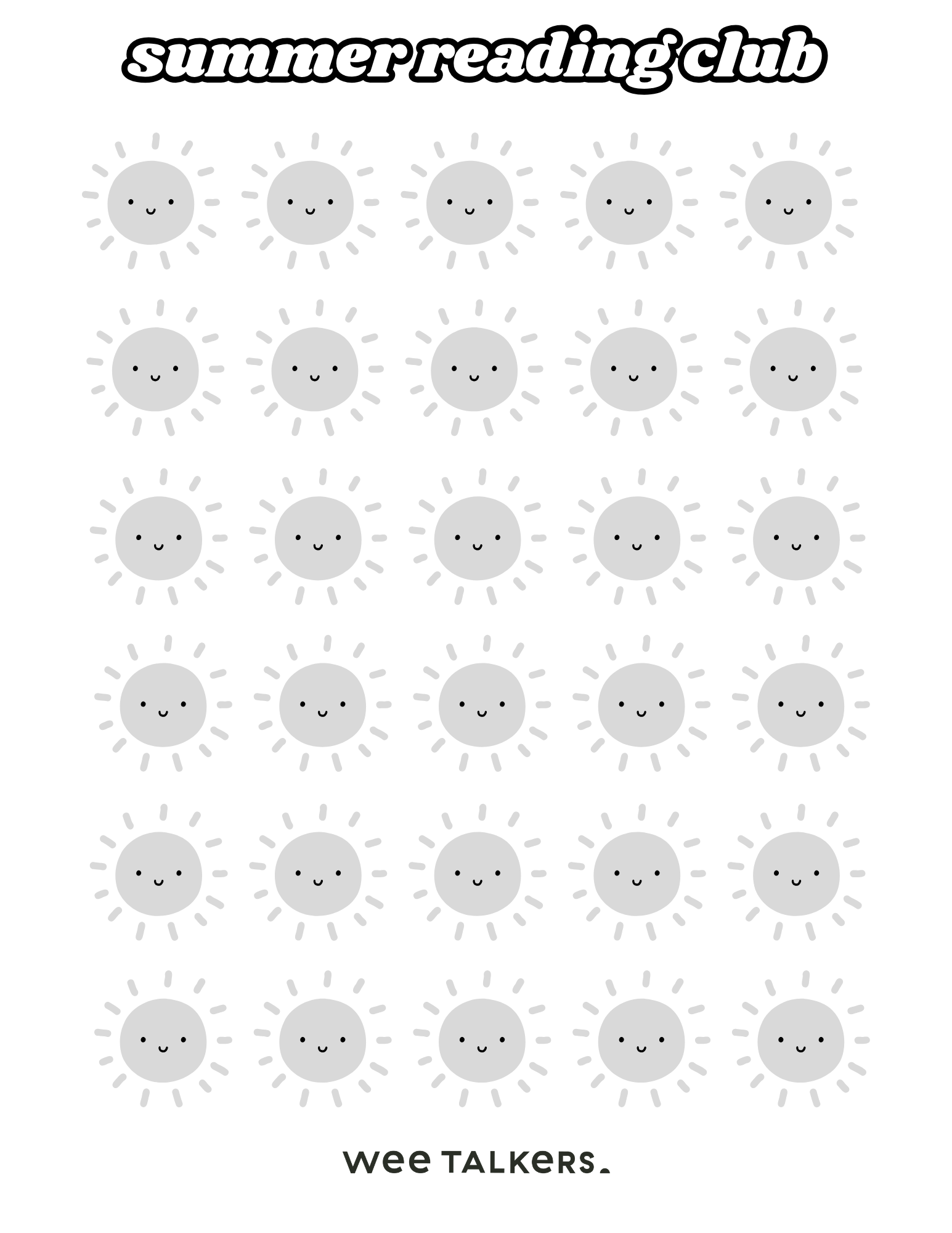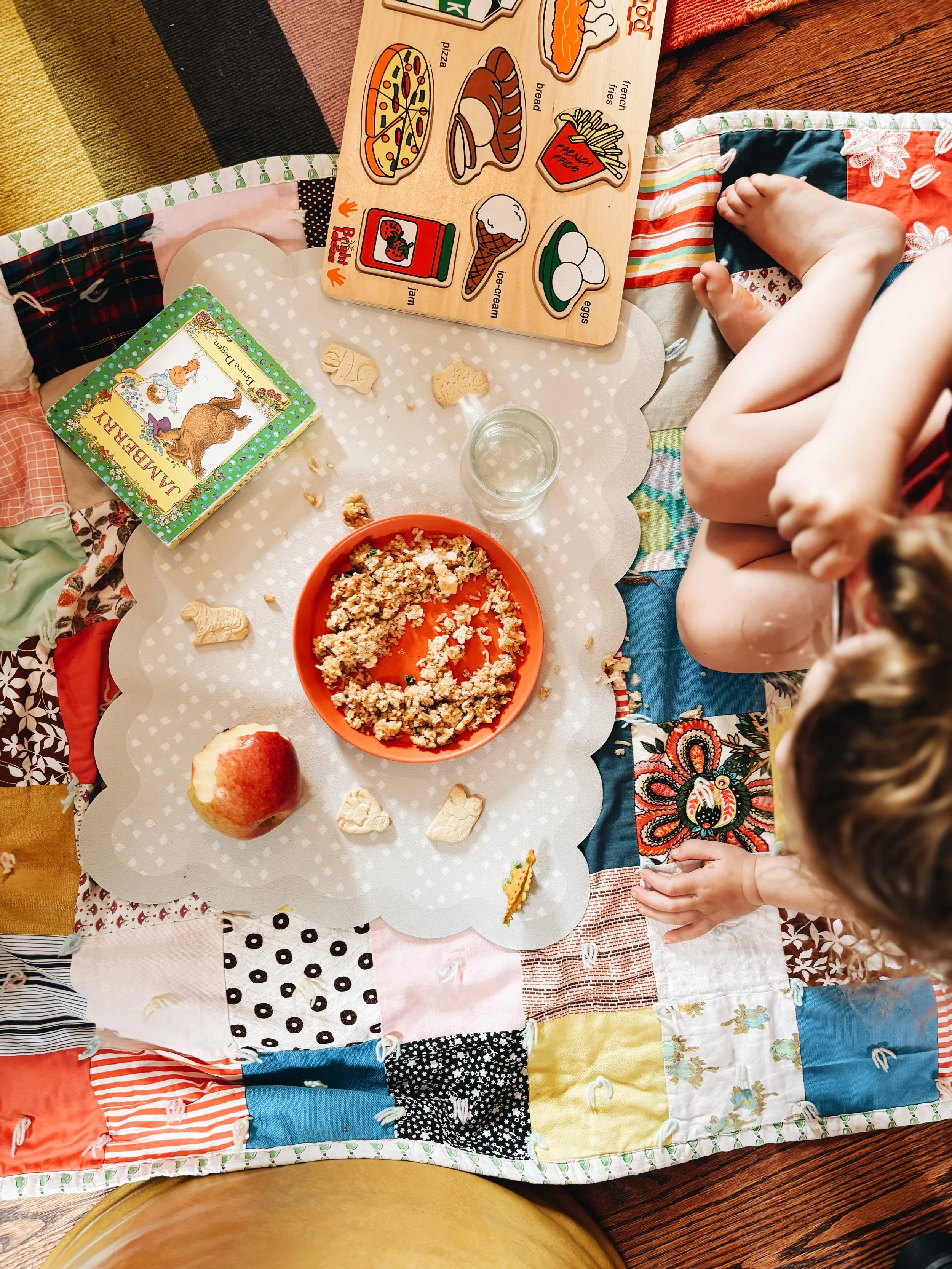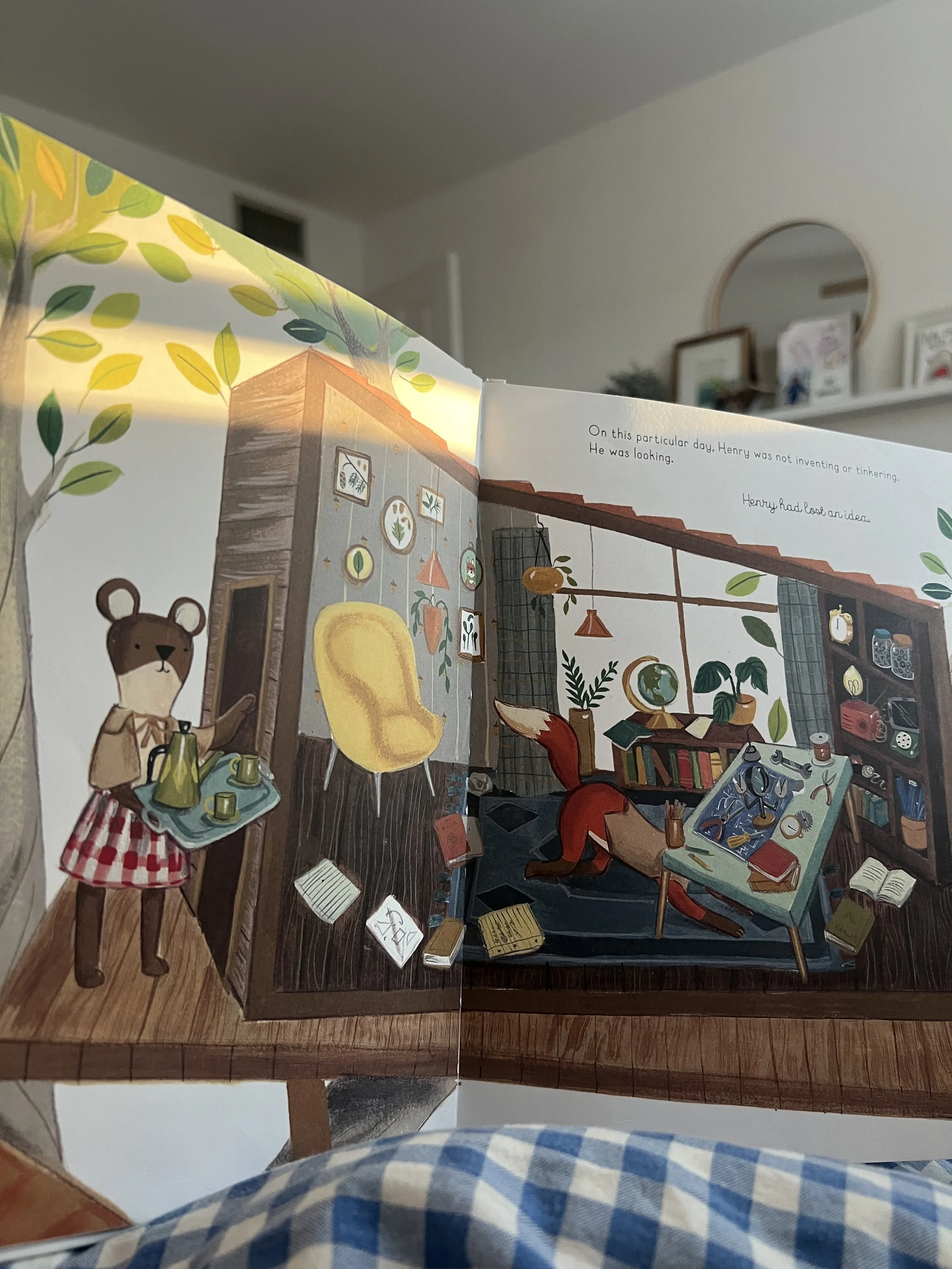Welcome to the club!
The goal of the Summer Reading Club is to make it easy for your family to enjoy meaningful, language-rich moments through stories, songs, and simple activities all summer long.
Below, you’ll find a list of fun, doable language and literacy activities. Whether you try one each day or just choose a few when the moment feels right, we hope they bring a little extra connection and joy to your summer days.
Have a question about an activity? Want to share a photo of your little one joining in the fun? We’d absolutely love to hear from you!
Email hello@weetalkers.com
Print out the reading tracker:
Make it official! Download and print our kid-friendly reading tracker to celebrate every book you read together. Let your child mark each one with a sticker, scribble, or stamp—whatever feels fun!
Read in a new spot:
Switching up your reading location can be so fun and help boost interest in books! Try reading outside, in a blanket fort, under the kitchen table, or in the bathtub!
Sing the BINGO SONG USING the letters in your child’s name:
This classic song isn’t just fun…it’s a great way to build phonological awareness, an early literacy skill that helps kids hear and play with the sounds in words. Try singing it using the letters in your child’s name or nickname (you can speed it up if their name is long!).
🎶 If Katie were singing it with her son, Henry, she would sing:
There was a boy who had a name
and Henry was his name-o!
H-E-N-R-Y, H-E-N-R-Y, H-E-N-R-Y
and Henry was his name-o!
Go to the library with your Wee Talkers’ library list:
We’ve put together a list of some of our favorite summer reads for toddlers and preschoolers—download it and take it with you!
Make a fun outing of it and spend time exploring the shelves, or place a few titles on hold and do a quick pickup. A fresh stack of library books is just the best!
Help your toddler make connections between a book and their life:
When toddlers link what they’re reading to real-life experiences, it helps deepen their understanding of language and builds vocabulary in a meaningful way.
EXAMPLES:
Look! He’s putting on his red shoes–you have fast shoes like that too, but yours are blue!
This dump truck is like the one we saw at the park this morning.
These little connections help words and concepts stick and makes reading feel more personal and engaging.
Clap out the syllables in your child’s name and the names of people in your family:
Syllable clapping is a playful way to build phonological awareness—an important early literacy skill. It helps your child break words into smaller parts, which supports future reading and writing.
Try it with family names or other important people:
👋 Ma-ma (2 claps)
👋 Os-car (2 claps)
👋 El-ea-nor (3 claps)
Make it fun! You can march, jump, or tap along with the claps too.
Talk about how a character might be feeling in a book:
Talking about emotions in books helps build both language and social emotional skills. When you talk about how a character feels, you’re giving your child words for their own experiences and feelings and helping them understand others’ emotions, too (building empathy).
Books specifically about feelings are great, but you don’t need a special book to start these conversations. Use the stories your child already loves and try saying things like:
😟 “He looks sad—his favorite ball popped.”
😊 “She’s smiling. I think she feels proud of her drawing!”
These little moments go a long way in building empathy and emotional vocabulary.
Here’s a social-emotional story time video your little one might love!
Play I-Spy
“I Spy” is a simple game with big benefits—it builds vocabulary, strengthens attention and memory, and supports early literacy skills like describing, categorizing, and noticing details. It’s such a great game to have in your back pocket!
Play it anywhere:
🚗 In the car
🛒 While waiting in line
🌳 On a stroller walk
🩺 In a waiting room
Examples:
“I spy something red…” or “I spy something that has wheels….” or “I spy something that starts with a mmmm sound (for older kids).
Put some fresh books (library or new) in baskets or low-hanging shelves
Books are more likely to be read when they’re easy to see and within reach. Take a look around your home—are books tucked away in your child’s bedroom or up high? Try placing a few books in baskets, on low shelves, or a pile on the coffee table so your child can grab one whenever the mood strikes.
You don’t need a full library setup—just a few favorite books in a visible spot can invite more spontaneous reading.
Create an obstacle course to practice words like “around,” “under,” and “through”
This one’s perfect for those longer summer afternoons when you need a quick activity. Use couch cushions, chairs, tape lines—whatever you have on hand—to set up a simple obstacle course, and talk your child through it using location words like “over,” “under,” “around,” and “through.”
These kinds of spatial words are important for understanding directions, following instructions, and building early language skills.
You can even try it at the park using playground equipment—give directions while your child climbs, crawls, and runs their way through!
Read a nonfiction book about something your child is interested in:
Don’t forget about the nonfiction section! These books often feature real photographs, which are especially mesmerizing to toddlers and preschoolers. They’re also packed with rich, complex vocabulary that boosts your child’s communication skills.
Nonfiction books help children build real-world connections and spark curiosity. Encourage your child to ask questions as you look through the pages together—whether it's about animals, vehicles, space, or how things work, you're encouraging curiosity and exploration!
If you need a jumping off point, we love this one, this one, and this one!
Reading time with a loved one (in person or on FaceTime!):
Whether it’s grandma, an older sibling, an uncle, or a sweet neighbor—switching up reading partners can bring a whole new energy to story time. Different voices, new favorites, and warm connection all make reading feel extra special.
Talk about words that start with the same sound as your child’s name:
Most children learn the letters in their own names first—especially the first letter. Talking about other words that start the same way (“B says “b” like Brody! A “b” like banana!”) helps build phonological awareness, an essential early literacy skill that lays the foundation for reading and spelling.
This is an easy one to weave into everyday life—during play, on a walk, or even at the grocery store. It feels extra fun because it’s all about them.
Find another book written by your child’s favorite author:
When kids connect with a certain author’s book, it might be because of the illustrations, the content, or the rhythm of the words. And more often than not, they end up loving other books by the same author too.
Check the library to see which other books they might have available by the same author. It’s a fun way to build on what your child already enjoys!
Practice telling the story of your day — “Today we…”
At the end of the day, invite your child to help you “tell the story” of what you did. Start with, “Today we…” and see what they remember! You can say most of it and have them chime in where they want, or for chattier toddlers and preschoolers, you can let them lead a bit more.
This simple routine supports story retell, sequencing (first, next, then), and vocabulary—all foundational skills for early literacy.
This story telling also helps your child make deeper connections between the words they hear and what they experience. Plus, it’s a really lovely way to reflect, connect, and wind down together.
Listen to some songs from the Wee Talkers’ Playlist:
Music is a powerful way to support language development—especially for toddlers and preschoolers. Songs naturally slow down language, making it easier for young children to process words. Repetition helps with memory and learning, and the playful nature of music takes the pressure off speaking.
And just as importantly? Music can shift the mood, ease transitions, and bring a little joy to your day.
Our Wee Talkers playlist is full of kid-friendly songs that won’t make you want to pull your hair out (#IYKYK) just feel-good tunes you’ll actually enjoy listening to together.
Tell a story using just the pictures! Skip the words and talk through it together:
You don’t always have to read the words to enjoy a book—sometimes the pictures tell the best stories. Using the illustrations to create the story helps build narrative skills, imagination, and expressive language—all essential for early literacy.
You can say things like:
“Whoa! What’s that dino doing?”
“Uh oh… what do you think she’s going to do?!”
This is also a great way to switch things up when you’re too tired to read a book the usual way!
Go on a “listening walk” – talk about the sounds you hear:
We often focus on what we can see, but listening is just as important—especially when it comes to early literacy. Taking time to tune into the sounds around you helps your child’s listening skills and allows them to think about sounds in language.
Take a walk together and notice what you hear—birds chirping, dogs barking, the crunch of leaves or sticks. Try asking, “What do you hear?” and take turns naming or imitating the sounds. It’s a simple way to build vocabulary, boost attention, and support your child’s listening and language skills.
Cook something together using a recipe. Point out the text:
Recipes are a great way to build print awareness (the understanding that printed words (and pictures!) carry meaning).
As you cook, point out the words for each step.
Sometimes we like to draw simple pictures to represent each step (like drawing an egg for an ingredient or a spoon for “stir”) helps them connect visuals with actions—an important step in understanding that symbols, including pictures and written words, represent ideas.
Listen to a Wee Talkers podcast episode:
Listening to audiobooks or podcasts can be just as wonderful as reading text when it comes to comprehension and building vocabulary for little ones.
Podcasts are our favorite for car rides, quiet times, or just when everyone needs some down time.
Inside your Songs + Stories membership, you’ll find podcast episodes specially designed for toddlers and preschoolers. Perfect for listening together or independently!
There are 2 summer-themed episodes in the summer book club section for your little one to listen to—When Summer Comes and Maisy Swims.
LIVE STORY TIME:
Join us for a fun, summer-themed LIVE story time! We’ll sing some songs, read a story together, and hang out for a bit!
🗓️ Wednesday, June 18
🕙 10:00am PST
We’d love to see you there! Check your email for the link to join 😊
Read a book you’ve never read before:
Reading the same beloved books over and over is so good for toddlers and preschoolers—but adding in a new title now and then brings fresh vocabulary, ideas, and excitement.
It might spark new interests, help stretch attention, or simply add a little novelty to your reading routine. Whether it’s from the library, a friend’s shelf, or tucked in the back of your own collection, try something new and see what lights them up.














